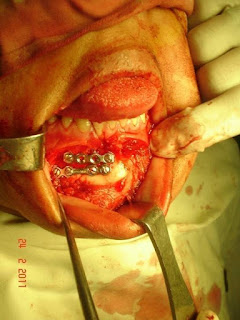Motion of the maxilla while the nasal bridge remains stable
Sunday, May 31, 2015
MAXILLARY FRACTURES LEFORT
Clinical
findings
Facial edema
Malocclusion of the teeth
Motion of the maxilla while the nasal bridge remains stable
Motion of the maxilla while the nasal bridge remains stable
Radiographic findings:
Fracture line which involves
Nasal aperture
Inferior maxilla
Lateral wall of maxilla
CT of the face and head
coronal cuts
3-D reconstruction
MAXILLARY FRACTURES
ž High
energy injuries.
ž Impact
100 times the force of gravity is required .
ž Patients
often have significant multisystem trauma.
ž Classified
as LeFort fractures
MAXILLARY FRACTURES LEFORT
Definition:
Horizontal fracture of the maxilla at the level
of the nasal fossa.
Allows motion of the maxilla while the nasal
bridge remains stable.
Saturday, May 30, 2015
Physical Examination
ž
Inspection
of the face for asymmetry.
ž
Inspect
open wounds for foreign bodies.
ž
Palpate
the entire face.
¡
Supraorbital
and Infraorbital rim
¡
Zygomatic-frontal
suture
¡
Zygomatic
arches
Physical Examination
ž
Inspect
the nose for asymmetry, telecanthus, widening of the nasal bridge.
ž
Inspect
nasal septum for septal hematoma, CSF or blood.
ž
Palpate
nose for crepitus, deformity and subcutaneous air.
ž
Palpate
the zygoma along its arch and its articulations with the maxilla, frontal and
temporal bone.
ž
Check
visual acuity.
ž
Check
pupils for roundness and reactivity.
ž
Examine
the eyelids for lacerations.
ž
Test
extra ocular muscles.
ž
Palpate
around the entire orbits..
Definitive Treatment
ž
Reduction
ž
Fixation
ž
Immobolization
|
Energency Management Airway Control
ž
Control
airway:
ž
Chin
lift.
ž
Jaw
thrust.
ž
Oropharyngeal
suctioning.
ž
Manually
move the tongue forward.
ž
Maintain
cervical immobilization
Energency Management Hemorrhage Control
ž
Maxillofacial
bleeding:
¡
Direct
pressure.
¡
Avoid
blind clamping in wounds.
ž
Nasal
bleeding:
¡
Direct
pressure.
¡
Anterior
and posterior packing.
ž
Pharyngeal
bleeding:
¡
Packing of the pharynx around ET tube.
History
ž
Specific
Questions:
¡
Is
there pain with eye movement?
¡
Are
there areas of numbness or tingling on your face?
¡
Is
the patient able to bite down without any pain?
¡
Is
there pain with moving the jaw?
|
According To Direction
|
Direction of fracture line and effect of muscle action
1. Favorable
Muscle pull in the same direction
minimizing displacement
2. Unfavorable
Muscle pull in different same
direction
displace proximal fragment.
( Management Protocol
ž
Primary
Resuscitation
ž
Definitive Treatment )
( Primary
Resuscitation
A. Airway maintenance with cervical spine
control
B. Breathing and adequate ventilation
C. Circulation with control of hemorrhage
D. Discerning neurological status of patient
E. Exposure of patient to facilitate a
complete physical examination)
|



























